II. CHAPTER TWO: 5.75 MILLION UNUSED NUMBERS IN THE 530 AREA CODE
Of the 7.76 million numbers in the 530 area code, companies hold 5.83 million. The other 1.93 million numbers have yet to be assigned to companies. The CPUC's utilization study found that of the 5.83 million numbers held by companies, 3.82 million remain unused in their inventories. Therefore, 5.75 million numbers in the 530 area code remain unused. A portion of these unused numbers can be made available for use by all companies, through the monthly lottery allocation process or through a future number pool. In addition, companies have reported 2.01 million numbers as unavailable. A portion of these unavailable numbers can be used more efficiently if the recommendations contained in this report are implemented.
C. THE SCOPE OF THE UTILIZATION STUDY
1. Distribution Statistics of Prefixes
The CPUC asked forty-six companies, holding 583 prefixes in the 530 area code, to report their utilization data with a reporting cut-off date of December 31, 2000. Table 2-1 shows the distribution of prefixes held in 530 by incumbent local exchange carriers (ILECs), competitive local exchange carriers (CLECs),17 cellular/PCS carriers and paging carriers in 131 rate centers.
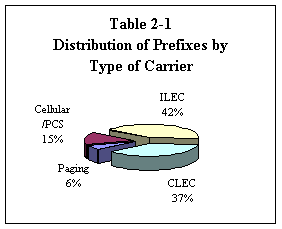
2. Carriers Reporting
Of the 46 companies in the 530 area code, 43 companies submitted utilization data. A list of the companies that have been allocated numbers in the 530 area code appears in Appendix A.
3. Non-Reporting Companies
The remaining companies hold six prefixes in the 530 area code. According to NeuStar, all three companies are out of business in California. Table 2-2 summarizes this information.
Table 2-2
Non-Reporting Companies
Company OCN Rate Center Prefix(es)
CRL Network Services 4128 N. Tahoe: Brockwy 442
CRL Network Services 8796 Yreka 460
San Diego Paging 6480 Chico 407
San Diego Paging 6480 Marysville 907
TSR Wireless Services 6483 Auburn: Main 648
TSR Wireless Services 6483 Davis 649
D. NUMBERS AVAILABLE IN THE 530 AREA CODE
1. 5.75 Million Numbers Available
The 530 area code has 5.75 million unused numbers. Of these unused numbers, TD found that companies held 3.82 million numbers in their inventories.18 These numbers held in inventory are currently not used but held in anticipation of future need. The remaining 1.93 million unused numbers are not yet assigned to companies and are made available in the monthly lottery. The breakdown of available numbers is shown in the table below.
__________________________________________________________________
Table 2-3
Summary of Available Numbers
Wireline Carriers 2,929,165
Wireless Carriers 793,525
Type 1 Carriers 98,598
Total Available Numbers Reported by Carriers 3,821,288
Numbers Available for the 530 Lottery 1,930,000
Total Available Numbers in the 530 Area Code 5,751,288
__________________________________________________________________
Not all of the 5.75 million unused numbers are immediately available to every company that wants numbers. Of the 5.75 million numbers, only 3.41 million numbers19 are estimated to be available to all companies via future pooling. The remaining 2.34 million unused numbers are only available to the companies who hold them. Pooling for the 530 area code is tentatively scheduled summer 2002. By setting up number pooling in the 530 area code and adopting recommendations in this report, 20 the CPUC could shift 0.97 million unused numbers to the category available to all companies. Of the 5.75 million unused numbers, those actions could result in making a maximum of 4.38 million numbers21 available to all companies with the remaining 1.37 million numbers available to the companies who hold them.
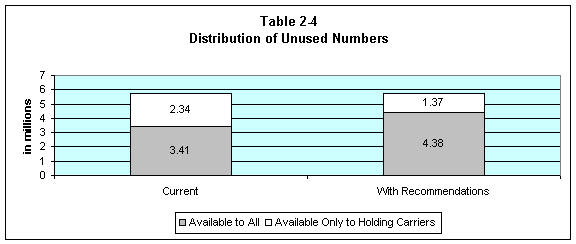
Current technology requires a company to be LNP-capable in order to donate numbers for another company to use. All wireline numbers in rate centers that are in the top 100 MSA's are required to be LNP-capable.22 Although number pooling has not started for the 530 area23, TD analyzed the 530 utilization data by percentage contamination to determine the availability of numbers that potentially can be used in a number pool. Wireline companies hold 2.93 million unused numbers in the 530 area code. In order for the unused numbers to be retrieved from company inventories, the FCC requires these unused numbers to be retrieved from blocks which are 10% or less contaminated.24 Of the wireline companies' 2.93 million unused numbers, 2.35 million are contained in 2,341 thousand-blocks held by LNP-capable carriers that are 10% or less contaminated. However, not all of these 2.35 million numbers can be retrieved from companies' inventories because companies need to have enough numbers to meet anticipated future need.25 Both the CPUC and the FCC have determined that six-months of inventory is a reasonable quantity to hold for future use.
The remaining 580,000 of the 2.93 million unused numbers cannot be retrieved, either because the numbers are in blocks greater than 10% contaminated or because they are in non LNP-capable blocks. However, companies can immediately use these numbers to provide service to their customers or meet other needs. Wireline carriers hold 414,000 numbers in blocks that are more than 10% contaminated.26 Non-LNP capable wireline carriers hold 80,000 of the 2.93 million unused numbers.
Wireless carriers hold 794,000 million unused numbers in the 530 area code. Of these unused numbers, 597,000 are in blocks that are 10% or less contaminated, while 196,000 numbers are in blocks greater than 10% contaminated. Until wireless carriers become LNP-capable in November 2002, none of these numbers may be reallocated to other companies. In the interim, wireless carriers may assign these numbers to their own customers.
E. ANALYSIS OF AVAILABLE NUMBERS
1. Analysis of Wireline Carriers' Contamination Rates
The CPUC requires each company participating in number pools to donate blocks that are 10% or less contaminated, excluding those retained for the six-month inventory.27
TD analyzed the 530 utilization data to determine the availability of numbers within blocks of different contamination levels to assess different contamination thresholds that could be employed in the number pool. The following table summarizes available numbers by contamination levels by rate center for wireline carriers.
Table 2-5
Wireline Available Numbers by Block Contamination Level 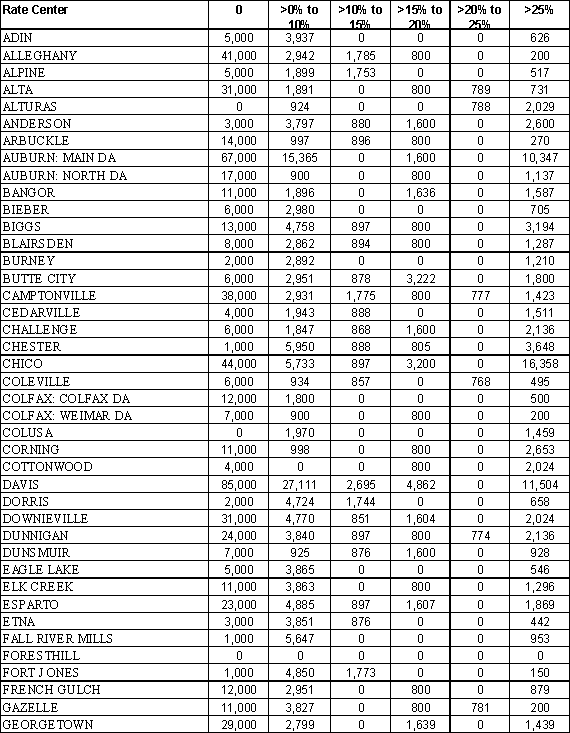
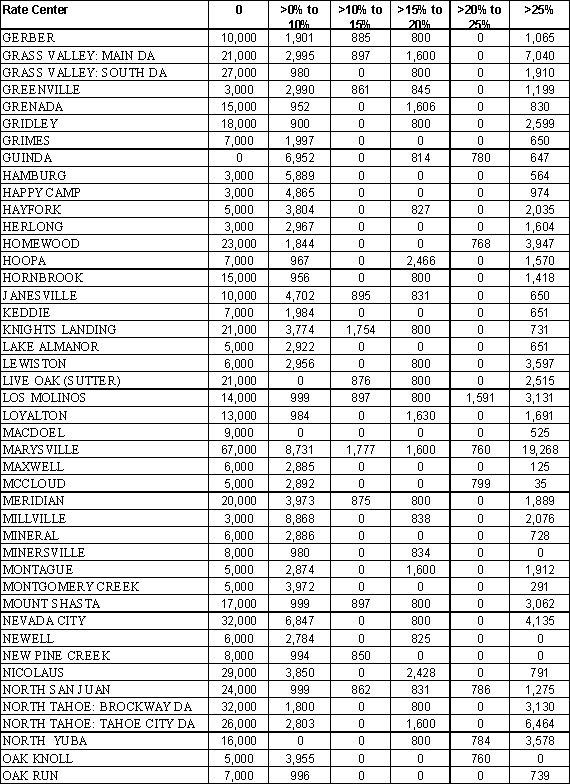
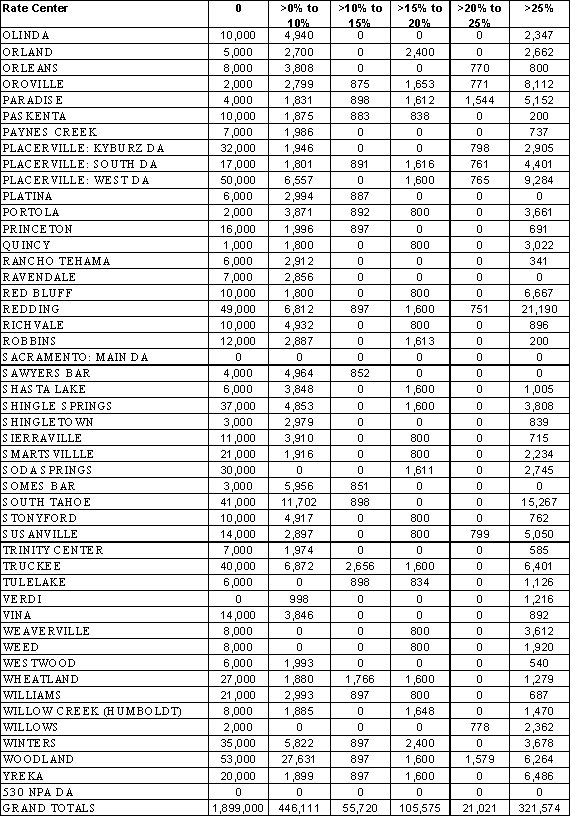
The first two numeric columns of Table 2-5 show the potential numbers available for number pooling, except for those numbers kept for companies' six-month inventory, under current rules. Available numbers in one rate center cannot be used in another rate center. Table 2-5 shows that two rate centers, other than Directory Assistance, have no available numbers that companies could donate to the pool. Foresthill only has one code which is non-LNP capable, Sacramento Main has one code in which all numbers are used for administrative purposes.
The next three columns of Table 2-5 capture available numbers in blocks that are greater than 10% contaminated but no more than 25% contaminated. Under the current number pool rules, companies retain thousand-blocks that are more than 10% contaminated. Increasing the contamination rate threshold from 10% to 25% would potentially free up an additional 182,31628 numbers for use in the number pool. TD cautions that although Table 2-5 shows potential results from increasing allowable contamination levels, further analysis and input from the industry may be necessary to determine accurately the quantity of additional numbers that can be added to the pool while still leaving companies with a six-month inventory.
As shown by Table 2-5 and also shown graphically in Table B-3 of Appendix B, most rate centers have available numbers from blocks of differing contamination levels up to 25%. The tables show that if the contamination ceiling for pooling were increased from 10% to 25%, more unused numbers exist in most rate centers that potentially could be donated to the pool.
Recommendation from Block Contamination Analysis of Wireline Carriers
· The CPUC should petition the FCC to increase the contamination level for pooling to 25%. If the FCC grants the petition, the CPUC should increase the maximum contamination level of donated blocks from 10% to 25% for all LNP-capable carriers.
2. Analysis of Wireless Carriers' Contamination Rate
Under current FCC rules, cellular and PCS companies are exempt from number pooling until November 2002 when they must become LNP-capable. The FCC has indefinitely exempted paging companies from becoming LNP capable. Table 2-6 shows available numbers in blocks of differing contamination levels held by wireless carriers. Wireless carriers hold 597,000 available numbers in blocks that are 10% or less contaminated, as shown in the first two columns of Table 2-6. Wireless carriers also have 107,000 available numbers in blocks with contamination levels greater than 10% but less than or equal to 25% as indicated by the next three columns of Table 2-6. Of these 705,000 unused numbers held by wireless carriers, TD estimates that 287,000 (41%) are held by paging companies. 29 TD staff is investigating whether there are methods to make some of these 287,000 unused numbers available to other carriers despite the FCC's exemption of paging companies from the LNP requirement.
Table 2-6
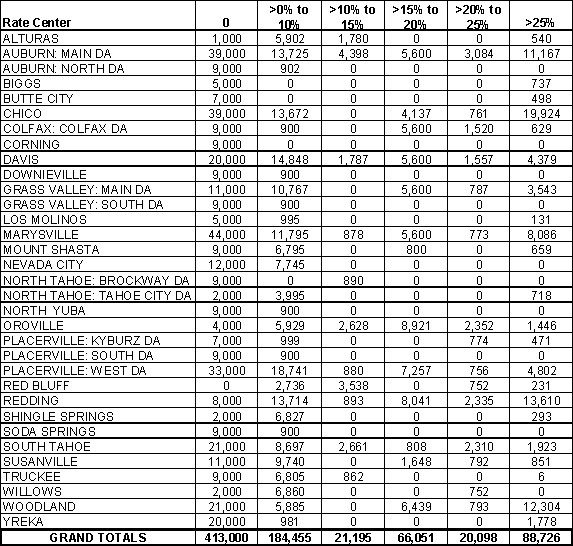 Wireless Available Numbers by Block Contamination Level
Wireless Available Numbers by Block Contamination Level
Because the FCC has granted wireless carriers an extension of time to implement LNP, no wireless carriers serving the 530 area code are capable of implementing LNP. Thus, wireless carriers cannot participate in number pooling at this time, resulting in 705,000 unused numbers in blocks between 0% to 25% contaminated in the 530 area code.
Recommendations from Block Contamination Analysis for Wireless
· When cellular and PCS companies become LNP-capable in November 2002, the CPUC should direct those wireless carriers to donate to and participate in the pool.
· The CPUC should adopt a 25% contamination threshold for donated blocks from wireless carriers to the pool.
· The CPUC should meet with paging companies to explore options for their consolidating numbering resources in fewer rate centers, as well as other methods of reducing the number of stranded numbers held by paging companies.
3. Potential Block Contamination Abuses
When blocks are slightly more than 10% contaminated, those blocks cannot be donated to the pool under current rules. Viewing the utilization data suggests that companies have not generally followed practices of sequential numbering and filling blocks substantially before using new blocks. The CPUC's rules on sequential numbering and fill rate practices promulgated in Decision 00-07-052 are designed to prevent this problem from occurring. Fill rates mitigate contamination by requiring companies to use contaminated blocks up to 75% before they can receive additional blocks. Sequential numbering minimizes contamination by requiring companies to begin assignment in the next thousand-block only after a 75% fill rate has been attained in the prior block. Where companies possess significant available numbers in a given rate center, these two efficiency measures could prevent the opening of new blocks or prefixes.
Companies reported utilization data as of December 31, 2000. The sequential numbering and fill rates decision was issued in July 2000. Some of these practices of non-sequential numbering and not filling blocks substantially before using new blocks may have happened before the July 2000 decision. TD does not expect carriers to contaminate blocks unnecessarily.
Recommendation for Block Contamination Issues Affecting All Companies
· The CPUC should monitor compliance with its fill rate and sequential numbering policies through future number utilization filings and audits.
· The CPUC should establish penalties for non-compliance with fill rate and sequential numbering policies adopted in Decision 00-07-052.30
4. Reclamation of Prefixes
Decision 00-07-052 directed companies to return prefixes that are held unused for more than six months. As shown in Appendix B-1, wireline carriers and wireless carriers hold 1,954,000 unused numbers and 413,000 unused numbers, respectively, in the 0% contaminated blocks. Of these 0% contaminated blocks, 560,000 numbers are in 56 whole prefixes, i.e. spare prefixes, while 1,807,000 numbers are scattered throughout many different prefixes. The following table shows the breakdown between wireless and wireline carriers.
__________________________________________________________________
Table 2-7
Breakdown of Numbers in 0% Contaminated Blocks
__________________________________________________________________
Avail. Numbers Avail. Numbers Avail. Numbers
0% Contain Blocks Spare Prefixes Differing Prefixes
Wireline Carriers 1,954,000 480,000 1,474,000
Wireless Carriers 413,000 80,000 333,000
Total 2,367,000 560,000 1,807,000
__________________________________________________________________
As shown above, 560,000 numbers in 56 prefixes can possibly be reclaimed if not used within six months. However, as a result of the FCC's March 31, 2000 first NRO order, the NANPA no longer has sole authority to reclaim unused prefixes. The FCC granted authority to state regulatory commissions to investigate and determine whether code holders have activated prefixes within the allowed time frames, and directed the NANPA to abide by the state commission's determination to reclaim a prefix if the state commission is satisfied that the code holder has not activated the prefix within the time specified in the first NRO order. Substantial cooperation between the CPUC and the NANPA will be required in order for the CPUC to exercise this new authority and determine whether a prefix should be reclaimed. Furthermore, the NANPA must still perform the mechanical steps to reclaim prefixes once the CPUC directs the NANPA to reclaim a prefix.
NANPA has provided to the CPUC a list of companies which have failed to report whether their assigned prefix(es) have been placed in service. The CPUC issued Assigned Commissioner's Ruling Requiring Carriers to Comply With NXX Code Reclamation Rules, dated December 21, 2000. In this ruling, the CPUC instructed the delinquent companies to comply immediately. Companies are to inform the CPUC either that the prefix(es) have been placed in service or returned, that the company was incorrectly included in NANPA's delinquent list, or the reasons the prefix(es) have not been placed in service. The CPUC will review the reasons and make a determination on whether the prefix(es) must be returned or reclaimed by NANPA, or whether an extension of time is to be granted to the company to place the prefix(es) in service. Any delinquent companies that fails to comply will be subject to penalties and sanctions.
F. ANALYSIS OF 2.01 MILLION "UNAVAILABLE" NUMBERS
In the following sections, TD recommends a series of policies designed to require companies to use unavailable numbers more efficiently. These policies would potentially free more numbers for use in the pool, to be allocated through the monthly lottery, or to be otherwise used by companies.
Companies report that 2.01 million numbers in the 530 area code are either assigned to customers or are used by companies for reserved, administrative, intermediate and aging purposes. Assigned numbers are those numbers that are currently being used by customers or equipment. Companies commonly refer to these numbers as "unavailable". Unavailable numbers include not only those actually in use by customers, but also the following categories:
· Reserved numbers - Numbers that are reserved in blocks for future use by specific customers;
· Administrative numbers - Numbers that companies use for their own internal use;
· Intermediate numbers - Numbers that are made available for use by another telecommunications carrier or non-carrier entity for the purpose of providing telecommunications service to an end user or customer; and
· Aging numbers - Numbers from recently disconnected service which are not reassigned during a fixed interval.
In its first NRO Order, the FCC ruled that companies must show that they have used a certain percentage of their existing inventory of numbers before they may obtain additional numbers in a given rate center. This order specified that companies' utilization rates will be calculated using only assigned numbers in the numerator. This method greatly increases companies' incentive to use numbers sparingly for purposes of reserved, administrative, intermediate, or aging numbers; none of those uses will raise a company's utilization rate and enable it to obtain additional numbers.
1. 1.65 Million Assigned Numbers
In the 530 area code, there are 1.65 million assigned numbers with 1.32 million assigned to customers by wireline carriers and 0.33 million assigned to customers by wireless carriers. Analysis of the utilization data submitted by wireline carriers reveals sharply differing utilization rates of ILECs and CLECs. While ILECs in the 530 area code are using 49.9% of their numbers, CLECs' data shows a utilization rate of only 16.6%. Likewise, analysis of wireless carriers' data revels sharply differing utilization rates of paging carriers and cellular/PCS companies. While cellular/PCS carriers in the 530 area code are using 45.6% of their numbers, paging carriers' data shows a utilization rate of only 7.1%. The percentage of assigned numbers to total numbers held by companies is shown in the table below.
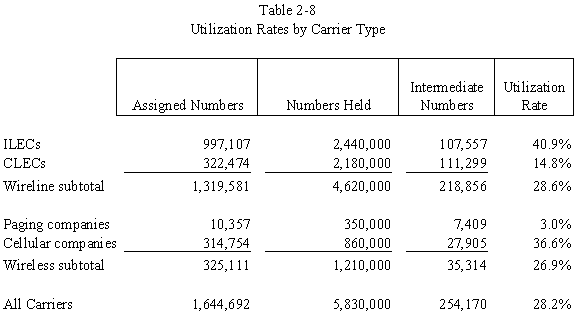
a. Non-Working Wireless
Non-Working wireless describes numbers assigned to wireless customer equipment, but which are not yet working. In the present study, these numbers are considered a sub-category of assigned numbers31. For example, wireless carriers sometimes pre-package a cellular telephone with an assigned telephone number for sale to customers. Although the number is assigned, it will remain inactive until a customer purchases the telephone. Only one company reported 5 assigned numbers in the non-working wireless category for the 530 area code. While the quantity of non-working wireless numbers reported is generally zero or very low, this sub-category of assigned numbers could increase because there are no restrictions on the number of days that a wireless company can hold these numbers, causing numbers to remain idle for an unspecified period.
The CPUC should consider several options to improve inventory management of non-working wireless numbers. One option is for the CPUC to require companies to return these numbers to the available category after 180 days (similar to the requirement the FCC has established for reserved numbers). Since pre-packaged equipment with non-working assigned numbers is often located in various retail outlets, another option is for the CPUC to require companies to maintain inventory records of all such retail/wholesale equipment with the associated numbers assigned and to require regular (weekly/monthly) updating of these inventory records. While TD thinks this is an area of potential abuse, the FCC's NRO Orders prohibit us from requiring regular reporting from carriers beyond their biannual NRUF reports. Audits by the CPUC may uncover or limit misuses of this category by carriers.
Recommendations for Treatment of Non-Working Wireless
· Non-working wireless numbers should be treated as reserved numbers and limited to 180 days, after which they should be classified as available for assignment to customers.
· The CPUC should continue to monitor non-working wireless numbers in the near term by reviewing future utilization filings, and should include this category of numbers in any audits conducted of wireless carrier number use.
b. Eliminating Interim Number Portability Releases Numbers for Reallocation
Interim Number Portability (INP) is the ability to move telephone service from one service provider to another using Remote Call Forwarding (RCF), Direct Inward Dialing (DID), or equivalent means. 32 Prior to the implementation of permanent LNP, companies entered into INP arrangements to enable the transfer of customers from one company to another. Under these INP arrangements, two telephone numbers are associated with each customer. LNP eliminates the need for two telephone numbers for each customer when the customers change companies because customers can take their numbers with them.
Since the 530 area code has portions which are included in the top 100 MSAs in the nation, all wireline carriers should be LNP-capable in the 16 rate centers which are in the top 100 MSA's. Two companies reported a total of 10,003 INP numbers in the 530 area code. An ILEC reported 3 numbers. A CLEC reported 10,000 numbers in the INP category. This is an extraordinary large number for INP and TD suspects these 10,000 numbers were mistakenly reported in this category. TD should investigate this prefix and reclaim the prefix if it is not being utilized.
Recommendations for INP-Related Conservation Measures
· The CPUC should adopt a schedule for transitioning INP arrangements to LNP in all California area codes.
· TD should investigate the whole prefix assigned to INP and reclaim the prefix if it is not being utilized.
c. Expanded Use of the 555 Prefix Could Release Other Prefixes Dedicated to Special Uses
Historically, the telecommunications industry has designated certain prefixes for special uses, usually to an ILEC. These include numbers for recorded public information announcements such as time-of-day, weather forecasts, high-volume call in numbers, and emergency preparedness33 numbers. These prefixes are not made available for general commercial use, and thus numbers within these prefixes that are not in actual use lie vacant. In 1999, companies decided not to duplicate the special use prefixes in each area code. Concerned that this process could adversely affect the public, the CPUC directed that these prefixes should be duplicated in each new area code.
The utilization study shows that 13 prefixes are dedicated for special uses: three for limited service, two each for time and directory assistance, and one each for repair service, test desk access, high volume calling, pseudo 800 service code, information provider service, and emergency preparedness. TD questions the necessity of assigning an entire prefix for each of the purposes listed above.
Furthermore, having multiple special use prefixes is an inefficient use of numbers in the 530 area code as well as in other area codes in California. For example, if the 555 prefix34 currently reserved only for directory assistance could be used to provide time and emergency preparedness then two more prefixes could be returned for reallocation in the 530 area code.
Similarly, expanded use of the 555 prefix throughout the state could result in more returned prefixes in other area codes. TD recommends that the CPUC initiate an investigation into broader use of the 555 prefix in California. The CPUC should further analyze the option of obtaining standard 555 numbers in every California area code to provide time, emergency preparedness, and weather information at no additional cost to customers.
Recommendations for Special-Use Prefixes
· TD recommends that the CPUC initiate an investigation into the possibility of moving the numbers for time and emergency preparedness into the 555 prefix.
· TD recommends that the CPUC include in its investigation the broader use of the 555 prefix in California's area codes by providing standard 555 numbers in every California area code to provide time, emergency preparedness, and weather information.
2. Reserved Numbers Are a Potential Source of Additional Numbers
Carriers "set aside" numbers for future use by customers.35 Previously, industry number assignment guidelines allowed companies to reserve a prefix for up to 18 months for customers' future use.36 The FCC's first NRO Order modified the number reservation period to 45 days. This 530 utilization study incorporated the FCC's 45-day requirement. The second NRO Order on Reconsideration changed the number reservation period to 180 days. This took effect on December 29, 2000.37
Companies reported a total of 79,000 reserved numbers in the 530 utilization study. 38 Wireline carriers reported a total of 56,000 reserved numbers in the 530 area code, which account for 1.2% of wireline carrier's total numbers. Wireless carriers reported about 23,000 reserved numbers in the 530 area code, which account for 1.9% of wireless carrier's total numbers. As stated in Section D above, under the utilization rules promulgated in the FCC's First and Second NRO Orders, carriers now have a much stronger incentive to minimize the quantity of numbers they reserve for future use by customers, thus freeing more numbers for immediate assignment to customers, or for donation to the number pool.
Recommendations for Reserved Numbers
· The CPUC should monitor reserved number use for all companies by reviewing future utilization data to ensure companies are complying with the FCC's 180-day requirement.
3. Administrative Numbers are a Potential Source of Additional Numbers
Administrative numbers are those not assigned to customers and are generally used for a wide range of applications for companies' internal use, including testing, internal business, and other network purposes. Companies reported over 65,00039 administrative numbers in the 530 area code. Wireline carriers hold approximately 48,000 of these numbers and wireless carriers hold approximately 17,000 of them. These quantities of administrative numbers represent 1.0% of wireline carrier's total numbers and 1.4% of wireless carrier's total numbers.
The utilization study revealed that companies exhibit a wide range of rates of administrative number usage. Given the variances in the levels of administrative numbers between companies and rate centers, it is unclear what basis companies use for placing numbers in this category. The CPUC should therefore pursue an investigation in this area.
Companies could conserve numbers by centralizing assignment of administrative numbers within one or a few blocks within one prefix. However, some companies randomly assigned administrative numbers in multiple thousand-blocks within the same prefix. Because of this practice, companies already have contaminated multiple thousand-blocks; thus, preventing them from donating blocks once they can participate in number pooling or other LNP-based conservation measures.
Also, some companies holding multiple prefixes in a given rate center randomly assign administrative numbers throughout different prefixes when they have the available number resources to centralize the assignment of these numbers in one prefix in that rate center. TD questions the need for companies to hold multiple prefixes in a given rate center, when they are using multiple prefixes to serve their internal purposes and not necessarily to serve customer needs.
4. Aging Numbers
The FCC's first NRO Order defines aging numbers as disconnected numbers that are not available for assignment to another customer for a specified period of time. Consistent with the Industry Numbering Committee (INC) Guidelines, the CPUC adopted the FCC upper limits for aging numbers as 90 days for residential numbers and 365 days40 for business numbers.
In the 530 area code, there are approximately 64,000 numbers in the aging category, representing 3.0% of the total unavailable numbers. While most companies track aging telephone numbers by business and residential categories, Pacific Bell, the largest single number holder in the 530 area code, does not differentiate and reported all its aging numbers in the "Residential" category for this phase of the area code studies. Therefore, the vast majority of the aging numbers in the residential category may give a false impression that most aging numbers are residential numbers.
Because Pacific Bell does not differentiate between residential and business in reporting aging numbers, it is uncertain whether Pacific is adhering to the maximum 90-day aging period for residential numbers, and whether, at the end of the 90-day period, Pacific is reassigning these numbers to the "available" category. Pacific Bell may be allowing residential numbers to be in the aging category for nine months longer than is permissible under both FCC and CPUC rules. The FCC's NRO Orders do not require carriers to report their aging numbers broken down into residential and business categories. Since Pacific has not voluntarily provided this breakdown as requested in its data submissions for the CPUC's number utilization studies, TD staff should focus particular attention on the issue of Pacific's adherence to FCC and CPUC time limits on numbers in the again category whenever it audits numbering data.
A higher percentage of aging numbers occurs in the wireless category, as compared to the wireline category. Aging numbers represent 3.9% of the total unavailable wireless numbers, or about 16,000 numbers. Aging numbers represent 2.9% of the total unavailable wireline numbers, or about 48,000 numbers. This is consistent with the higher turnover or "churn" that occurs in the wireless industry. Appendix G shows the breakdown of aging numbers by wireless and wireline categories.
Recommendation for Aging Numbers
· Although the CPUC has required all companies to differentiate aging numbers between residential and business and track the two categories separately, Pacific Bell has not complied with these requirements. TD staff should check Pacific's adherence to FCC and CPUC time limits on numbers in the again category when it audits numbering data.
5. Intermediate Numbers
The "intermediate number" category was only recently introduced by the FCC in its first NRO Order. This category tracks numbers that companies make available for use by another telecommunications carrier or non-carrier entity. Companies reported a total of approximately 254,000 intermediate numbers in the 530 area code. Wireline carriers hold 219,000 of those numbers and wireless carriers hold 35,000. The quantity of intermediate numbers varied significantly among rate centers in the 530 area code. 41 Since the intermediate number category is new, the quantity of numbers reported by companies may increase over time as more companies become familiar with this category. TD notes that this number use category has the potential for abuse by companies if they use significant quantities of number resources for intermediate purposes. Therefore, TD recommends the CPUC continue to monitor intermediate number use.
Recommendation for Intermediate Numbers
· The CPUC should monitor intermediate number use for all companies by reviewing future utilization filings to test whether potential abuses in this reporting category occur.
a. Type 1 Numbers
Wireline carriers allocate numbers for use by wireless carriers through Type 1 interconnection agreements.42 Because wireline and wireless carriers share responsibility for Type 1 numbers, both types of companies reported on these numbers. Wireline carriers report Type 1 numbers in the Intermediate category since they provide these numbers to another company. Wireline carriers also list the wireless carriers to whom they distributed ranges of numbers. Wireless carriers report on the numbers they received, placing them in the Assigned, Administrative, Reserved, Intermediate, Aging, or Available categories.
Record keeping of Type 1 numbers is inadequate because, more often than not, wireline carriers' reports disagreed with wireless Type 1 carriers' reports. In the 530 area code, 75% of all Type 1 numbers are unaccounted for or mismatched.43 In some cases, wireless Type 1 carriers deny "owning" the numbers that wireline carriers report as distributed. In other cases, wireless Type 1 carriers go out of business and do not return their numbers to the wireline carrier. In either case, numbers are lying dormant, used by neither the wireline or wireless Type 1 carrier.
In today's scarce numbering environment, it is unacceptable to let numbers go unused because of inadequate record keeping. Wireline donor carriers currently do not monitor wireless Type 1 inventories, nor do they proactively reclaim unused Type 1 numbers from wireless carriers. TD recommends that wireline carriers perform a one-time inventory check on Type 1 numbers to confirm that the numbers they have distributed are acknowledged by the recipient wireless Type 1 carrier. If errors are discovered, the wireline carriers should count the numbers as part of their own inventories.
Improved Type 1 number management is particularly crucial because unlike numbers held by most wireless carriers, Type 1 numbers are eligible for number pooling.44 Therefore, once wireline carriers recover unused Type 1 numbers, these numbers could be made available for pooling. Despite the problems with reporting, TD has identified 7 blocks of Type 1 numbers in the 530 area code that may be eligible for donation to the pool.45 The CPUC should recognize Type 1 numbers as a resource for number pooling and take steps to have wireline companies recover unused Type 1 numbers for donation to the number pool.
As described in Chapter One, state and federal mandates require most companies to demonstrate efficient numbering practices before becoming eligible to obtain more numbers. In contrast, Type 1 wireless carriers have no check on their number use because they draw numbers directly from wireline companies, therefore avoiding the scrutiny of the official number administrator. TD recommends that Type 1 wireless carriers be subject to number conservation measures, and the CPUC should develop a system to ensure compliance.
Recommendations for Type 1 numbers:
· Wireline and wireless carriers should improve Type 1 number inventory management. Wireline carriers should perform a one-time inventory check of wireless Type 1 numbers to verify their records match that of the wireless Type 1 carriers' records. Companies should make inventory data available to the CPUC upon request. Wireline carriers should recover and add to their inventories any Type 1 numbers lying dormant.
· Type 1 carriers should be subject to number conservation techniques such as sequential numbering and fill rates. A system to ensure compliance with Type 1 number conservation measures should be developed.
· The Commission should consider Type 1 numbers as potential donations to the number pool. Excess and unused Type 1 numbers should be returned to the wireline carriers and either used to serve customers or donated to the number pool
.
6. The Need to Audit the Data
The data analyzed in this utilization study was self-reported by companies. Given the area code crisis in California, the CPUC should audit the data for two reasons. First, verifying number usage data is important to ensure that the public resource of telephone numbers is efficiently managed. Second, audits will help verify whether companies are complying with CPUC and FCC rules for number usage.
Recommendation for Audit
17 Wireline carriers are composed of ILECs and CLECs. 18 A detailed break-down of the available 3.82 million numbers is shown in Table B-1 in Appendix B. 19 3.41 million numbers is comprised of 1.48 million estimated pooling donations by companies, plus 1.93 million available through the lottery. 20 Recommendations dealing with receiving authority from the FCC to increase contamination threshold rates (25%) for pooling, recovering blocks from special use codes, and recovering unused numbers from non-LNP capable carriers and Type 1 carriers as described later in this report. 21 See Table B-2 in the appendix for a detailed breakdown of the 4.38 million numbers. 22 Although all wireline carriers in rate centers that are in the top 100 MSA's are required to be LNP-capable, three wireline carriers in the 530 area code remain non LNP-capable in one or more of the rate centers that are located within one of the top 100 MSA's. 23 Rulemaking 95-04-043. 24 10% or less contaminated means that out of 1000 numbers in a block, 100 numbers or fewer have been classified as unavailable. 25 Future need may include serving new customers or offering new services. 26 See Table B-1 in Appendix B. The 432,626 is comprised of 57,990 which are in blocks that are 10-15% contaminated, 68,620 from 15-20% contaminated, 16,265 from 20-25% contaminated, and 289,751 numbers which are in blocks that are more than 25% contaminated. Later in this chapter, TD recommends additional steps that can be implemented to make more of the 432,626 numbers available for number pooling. 27 INC's Thousand Block (NXX-X) Pooling Administration Guidelines, dated January 10, 2000, state that carriers should donate specified thousand blocks. 28 Additional numbers from three columns of Table 2-5: 55,720+105,575+21,021=182,316 29 See Table B-2, Appendix B, for the derivation of this estimate. 30 See Chapter 1 for the discussion on Decision 00-07-052. 31 The FCC's First NO Order stated, "Numbers such as dealer number pools should be included as a subcategory of intermediate numbers." The definitions in the FCC's NRO Orders will govern companies' NRUF submissions and utilization rates for meeting utilization requirements. 32 Remote Call Forwarding allows a customer to have a local telephone number in a distant location. RFC is similar to call forwarding on a residential line, except that the RCF customer has no phone, no office and no physical presence in that location. Direct Inward Dialing uses a trunk from the central office which passes the last two to four digits of the Listed Directory Number into the PBX, thus allowing the PBX to switch the call to the correct extension without the use of an attendant. Existing DID retail service is limited to PBX services. For purposes of providing INP, DID switch functionality is used to provide INP to any CLC customer regardless of the type of terminal equipment used on the customer's premises. 33 The emergency preparedness prefixes are for services other than 911. 34 The number used for inter-area code directory assistance, which is uniform throughout California, is 1-XXX- 555-1212. This number has been designated for this use at the federal level. 35 An example would be a customer request for 2,500 numbers to be used in 2000, coupled with a request to have the next 2,500 numbers in sequence "reserved" for the customer to use in 2001. 36 Central Office Code (NXX) Assignment Guidelines, prepared by the Industry Numbering Committee, January 27, 1999 version, Section 4.4. 37 See FCC Order 00-129, Paragraph 114 38 See Appendix D for a breakdown of reserved numbers reported in the 530 NPA by rate center. 39 86,000 administrative numbers include 10,000 administrative numbers reported in the 530 Directory Assistance rate center. 40 In the first NRO Order, both 360 days and 365 days were used as the time period for aging business numbers. In a clarifying order, the FCC adopted 365 days as the aging period for business numbers. When the CPUC sent out the parameters for utilization data for this study, the 360 day time period for aging business numbers was used. In order to be consistent with the time frames the FCC adopted, the CPUC is now using the 365 time period for aging business numbers. 41 See Appendix F for a breakdown of intermediate numbers held by wireline and wireless carriers. 42 Type 1 numbers are programmed in the wireline carrier's end office, but are used by a wireless carrier. 43 165,625 out of a total of 221,298 Type 1 numbers are unaccounted for or mismatched. 44 Type 1 numbers given to wireless carriers are from prefixes in which LNP has already been initiated by the wireline carriers. Because Type 1 numbers reside in the wireline carrier's end office, Type 1 numbers are LNP-capable and thus suited for pooling. 45 These blocks are 10% or less contaminated.· The CPUC should audit the data submitted by companies in this study and future area code number utilization studies.
